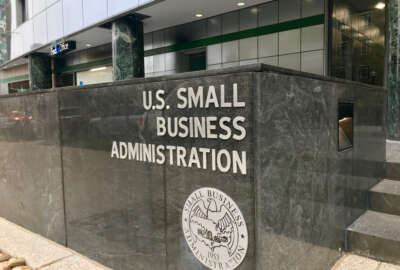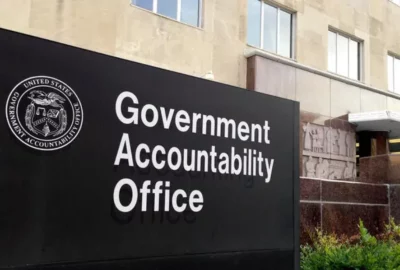Granter of billions joins the elite at a DC academy
Dale Bell is not a venture capitalist or a construction financier. But he's a new inductee of the National Academy of Public Administration.
If this were a garden party, my next guest might answer the what-do-you-do question like this: I give out billions of dollars every year. Dale Bell is not a venture capitalist or a construction financier. He’s the deputy assistant secretary for the Office of Grants at the Health and Human Services Department and a new inductee of the National Academy of Public Administration. Bell joined the Federal Drive with Tom Temin to discuss.
Interview transcript:
Tom Temin: And you kind of do give out billions and billions of dollars a year. Give us the scope of granting and then we’ll talk about how it works at HHS.
Dale Bell: Sure. So HHS is the largest grantmaking organization in the world. My job is not to necessarily give those grants out, but I do oversee the grant process of 14 different award-making agencies. And those include things like NIH, CDC, Medicare and Medicaid, Children and Families, HealthCare, Health Services Administration and things like that. So I’m not signing those grants, but I am responsible for ensuring that the process is fair, equitable in compliance and supporting the missions of those organizations.
Tom Temin: You’re almost like the chief procurement officer of the department. You’re not the contracting officer on each and every buy, but you have to kind of oversee what goes on.
Dale Bell: That’s exactly right. Now, grants and contracts are different ways of giving money out. So for contracts, what the government’s doing is procuring services for its use, whereas grants or procuring services to achieve a public good, which means we are much more involved with the community in achieving the outcome we’re trying to get to.
Tom Temin: And in round numbers, what is the grant obligation for HHS each year?
Dale Bell: It really depends on the year, but $900 billion to a trillion is what’s going through HHS.
Tom Temin: That’s real money.
Dale Bell: That’s certainly is.
Tom Temin: It must dawn on you that you have a gigantic amount of leverage on health-related research, which is a pretty broad field.
Dale Bell: It certainly does. And we do have organizations that are specifically focused in those areas: NIH, FDA, HRSA/Health Resources Service Administration. There is a large component of the HHS portfolio that does that. An even larger portion, however, really relates to public health and direct interaction with the communities.
Tom Temin: And how do you ensure that there is uniformity in the application of all of the processes and standards for grants? Clearly, the subject matter experts have to decide who’s a worthy grantee. But beyond that, there’s got to be some kind of a framework.
Dale Bell: That’s exactly right. So back in 2015, OMB took the seven different guiding documents. They were called circulars and smushed them all together into something called 2 CFR 200 administrative requirements. It’s an unsexy name, but what it did really was create one place where every federal agency was given instruction and guidance on how to do grants. Now, that is translated into each of our environments, our agency environments, through an office like mine. And that allows programs then to take that framework and then insert the correct merit review principles, criteria, eligibility. All those things happen at a program level, but the structure and the framework is what comes out of this guidance and then is pushed into the agencies.
Tom Temin: It’s almost like your own Federal Acquisition Regulation (FAR) for the grant side.
Tom Temin: That’s exactly right. It’s exactly right. And it has to be more flexible because of the nature of grants. Again, it’s a public good. It’s done through a third party, which means that we are partnering with thousands and thousands. I think HHS has 15,000 awardees per year. And each one of those people, each one of those organizations, is a partner with us in achieving the HHS goals.
Tom Temin: And would you say that if you look at the government as a whole, it’s getting a better handle on the metrics and data around grant and grant management?
Tom Temin: Right. So what is it the GAO says, ‘Much has been done. Much is needed.’ So, yes and we still need to move forward. Now, one thing that happened a year ago is OMB created a group called the Council on Federal Financial Assistance, or the COFFA rhymes with sofa. And the COFFA has 24 grant-making agencies on its board. And like the FAR Council, like the CFO Council, our job is to raise agency-specific challenges to a federal level and then resolve them to create the appropriate level of standardization and accountability that is then pushed back into the agencies.
Tom Temin: Because grantmakers need the same visibility into, just, for lack of a better word, the supply chain because the grantee is not the sole spender of all that money. They have sub grants and suppliers and so forth. Even contractors that are using that grant money in the same way that a acquisition contract might then devolve into a whole supply chain.
Dale Bell: That’s right. That’s exactly right. There are other mechanisms that this can happen through. They’re called consortium when individuals join together to achieve an outcome. But the way you’ve described it is right on the money.
Tom Temin: We’re speaking with Dale Bell. He’s deputy assistant secretary for the Office of Grants at Health and Human Services and a new inductee to the National Academy of Public Administration. And we kind of joked at the beginning at garden parties what do you talk about? But how did you come to this particular branch of work?
Dale Bell: I was in the professional services area for about 15 years.
Tom Temin: Industry in other words?
Dale Bell: That’s right. Exactly right. As a consultant, I started out with Arthur Andersen and then moved to a couple of IT firms, and I was in an organization called Touchstone. And Touchstone was a great little firm, really forward-leaning. And one of my clients was the National Science Foundation. And my job there was to help organize shared services around grants as part of an OMB assignment. And NSF was the co-lead and my client there, Mary Santonastasso, was such a great client that when she said, ‘I have a deputy position coming up, would you think about joining?’ I knew she’d be a great manager, a great boss, a great mentor and I took it. I always felt like I was going to switch teams at some point, and this was an incredible opportunity. So five years in, I became the director and then seven years in about 2022, I felt like it was time for me to take on a new challenge, a new organization. And it’s not like you ever solve a problem, but at least you’re talking to new people and you just learn how to manage issues in a new environment. And I’ve just been so excited to be at HHS for all the reasons that you mentioned. It’s, I believe, the most impactful grant making agency in the United States.
Tom Temin: And you’ve been a fed then about 10 years.
Dale Bell: Fourteen.
Tom Temin: Fourteen years.
Dale Bell: Yeah. Twelve at NSF and two here at HHS.
Tom Temin: And at the level you operate at, what does a typical day look like?
Dale Bell: Tom, all I do is talk all day long. It just.
Tom Temin: You could be in radio?
Dale Bell: I don’t know about that. But essentially my portfolio is crazy fun. There is the part where I work on behalf of HHS to provide oversight and ensure the policy environment. And then there is because HHS is the leader in so many of things that are grants, we also have externally facing work having to do with grants.gov, which is a place where everybody goes to find federal grants. We also operate GrantSolutions, which is a federal shared services for grants management. GrantSolutions supports 12 other federal agencies and in the IT of grants and we do data standards, which was part of something called the great act where HHS and OMB were jointly responsible for creating the language so that systems and communities and agencies could all talk to each other. And that is an ongoing, generally generational assignment.
Tom Temin: And I wanted to ask you about another parallel function. We’ve talked about procurement and how it resembles grants in some fashion. Rule making is something that a lot of federal agencies do. And complicated and fraught as it sometimes seems, by most measures, the U.S. government’s approach to rule making is pretty much emulated around the world. Is the gold standard. Would you say that’s the case for grant making in the United States? And do you look at how other countries do grants?
Dale Bell: So at NSF, we did a lot of that work looking at how other countries do regulation environment, particularly for R&D. In terms of HHS and rule making, we do follow the normal course. And although it can feel like you are death by a thousand cuts, what it really does is create an environment in which all the voices are heard, whether it’s public posting or addressing public comments, every one of them, before you can move forward. I would agree that as frustrating as it feels of all the ways of doing this, they’re all terrible. This one is the best by far, I believe.
Tom Temin: But what about grantmaking and the way other nations do that? Is that something also you’ve looked at?
Dale Bell: Well, we have. And what we found is they’re often coming to the U.S. to find out what we’re doing. So, as you said, there seems to be a lot of benchmarking against our processes, specifically around grants management. The thing about grants is that it’s really a programmatic endeavor, and that means that you have to have flexible approaches to how you give a grant out. And that is not quite the case with FAR, although the FAR has a number of flexibilities to ensure speed, quality and to deal with the circumstances. If you’re going to tap into the expertise of your communities, you need to be able to interact with them in a way that is meaningful and effective in getting them to join you as a partner. And at the same time, you need to make them accountable for this relationship as well. And that is a different type of organization. And what we try to do is find the right balance between the oversight, monitoring and compliance component against the outcome and the need for flexibility in how to achieve the goals that you’re looking at.
Tom Temin: And let’s talk about this from a professional standpoint for just a moment. It’s rare or not unheard of for people to come from industry into government. Often they just stay a couple of years and then they, so to speak, cash out. You’ve been a fed, as you mentioned, 14 years, which means you didn’t just come for a little stint. It sounds like you’re gone native, you might say. What do you tell people that are in industry about, say, the advantages of coming into government because it’s not necessarily financially advantageous?
Dale Bell: Right. Well, having been a consultant, I felt like I was perpetually having to balance three different objectives, not all my objectives. One is the consultant’s perspective. I need to learn, grow and keep moving. There’s the client perspective. I need a good resource. And then there’s the company perspective, which is I need to make funds. So you’re perpetually running around with three different voices in your head. And when you become a fed, what you get is one voice, which is how do I maximize service and value for the American people? And that clarity is worth any difference in cost. That ability to say, this is what I stand for, it’s not the bottom line or it’s not for this particular program, but it’s for the public good overall and it’s compelling. Often, they call that the passion tax. That is when you get a job that you love so much that you’re OK with not making as much as you could. Well, that’s what public service is.
Copyright © 2025 Federal News Network. All rights reserved. This website is not intended for users located within the European Economic Area.
Tom Temin is host of the Federal Drive and has been providing insight on federal technology and management issues for more than 30 years.
Follow @tteminWFED






